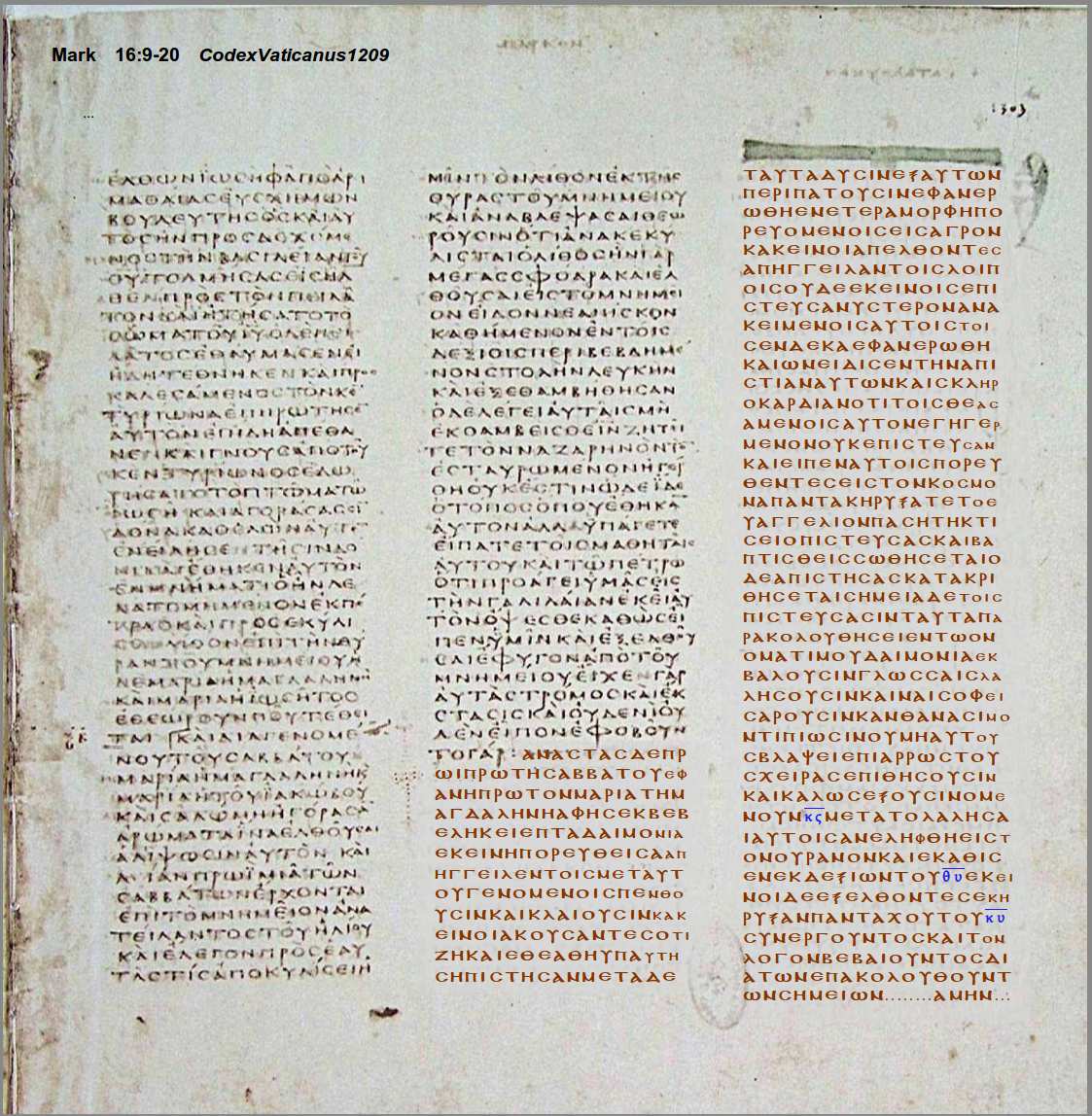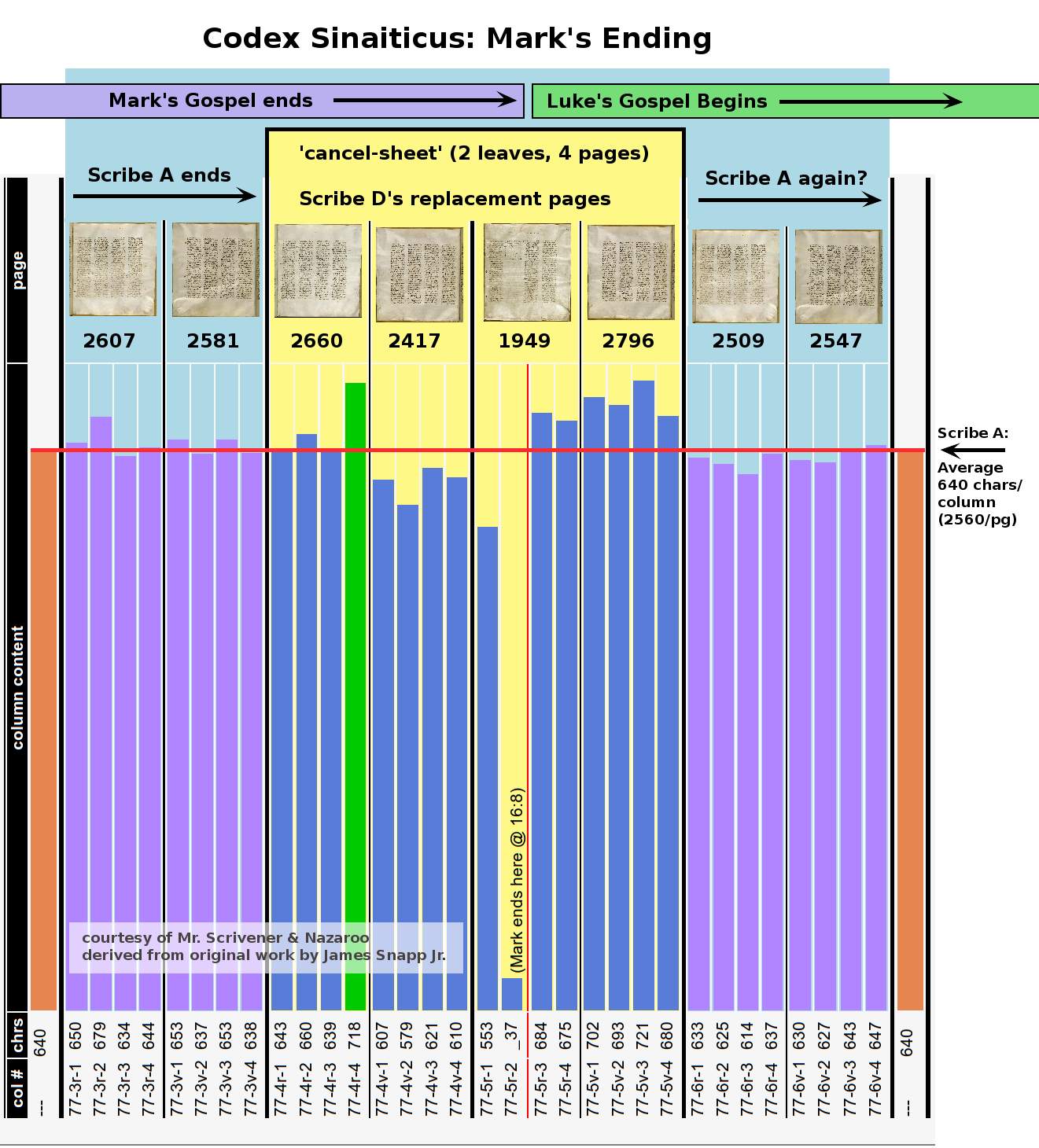Here's the latest on Mark's Ending by James Snapp Jr.:
An Open Letter to John MacArthur, the Staff of Grace To You, and the elders of
Grace Community Church.
In 2007, at
Pulpit Magazine » Blog Archive » A Short KJV Detour (Part 3) ,
there is a statement at the Pulpit Magazine blog stating the following about
Mark 16:9-20.
"Mark 16:9-20 has evoked no end of critical discussion. Many believe that this
questionable passage should be deleted since it is used to back up the claims of
charismatics; others, Grace Church included, believe that it should be
considered part of the authorative text and rightly interpreted."
This is, it seems, related to a booklet called "The Biblical Position on The KJV
Controversy," which is online at, among other places,
The Biblical Position on the KJV Controversy[bless and do not curse] --[bless and do not curse] John MacArthur , where it is noted that
copies of it can be obtained by writing to Grace Community Church in Sun Valley,
California. That is where John MacArthur preaches, and at its preface and its
conclusion, there is the name John MacArthur, as if the author was John
MacArthur. In that presentation, I find the following statement:
"You mention Mark 16. That text has evoked no end of critical discussion. For
many, they delete it because it simply solves some of their theological hangups.
I know we differ on the charismatic issue and quite honestly, it would be easy
for me to hide behind the cloak of textual criticism and conclude that because
it's not in some of the manuscripts, that therefore, verses 9 ff. are to be
deleted. The evidence is not conclusive for either side, but a good case can be
made for the inclusion of Mark 16:9-20 and I myself believe that it should be
included and then rightly interpreted."
In the 1997 edition of the MacArthur Study Bible, a note about Mark 16:9�20 has
a slightly different nuance but remains rather diplomatic on the subject. The
note briefly mentioned that "While the majority of Gr. manuscripts contain these
verses, the earliest and most reliable do not," and echoed some of Metzger's
observations about the non-transition between 16:8 and 16:9. But it closed by
saying the following: "In spite of all these considerations of the likely
unreliability of this section, it is possible to be wrong on the issue, and
thus, it is good to consider the meaning of this passage and leave it in the
text, just as with John 7:53�8:11."
The admission by Dr. MacArthur that many people delete Mark 16:9-20 in order to
solve some theological difficulty was interesting. But what seems more
interesting to me is the comparison between the statement in the letter, the
similar statement in "The Biblical Position on The KJV Controversy," the note in
the MacArthur Study Bible, and John MacArthur's recent sermon about the ending
of the Gospel of Mark.
On June 5, 2001, in a sermon, a transcript of which is at
The Fitting End to Markâs Gospel (6/5/2011) , the following about Mark 16:9-20:
"Frankly, I think it's a bad ending."
Now, it's not easy to interact with a sermon the way one would interact with,
say, an academic article. The argumentation is different, there are direct
theological principles in play, and one simply cannot write honestly about a
sermon and pretend to be a Vulcan. I insist on the right to express a little
emotion in the following response to Dr. MacArthur's sermon. I have tried to
hold him accountable, and at the same time I have tried to discern what led him
to say the things that he said. I am sure that he would be the first to
encourage his congregation and his radio audience to follow the Scriptural
command to test everything. I tested his sermon, and found some things wanting.
Test this response, and consider whether or not Mark 16:9-20 deserves to be
called a "bad ending."
As Dr. MacArthur began, he stated, "I understand the science and the history of
manuscripts and the passing down of Holy Scripture. That is one of the most
important things you learn in seminary."
It's helpful, I suppose, to establish that you know what you are talking about
when you are about to say something that might sound surprising to some of your
listeners. That is why Dr. MacArthur said this; it was not self-advertisement
for its own sake. After hearing this sermon, however, I have serious doubts
about Dr. MacArthur's grasp of New Testament textual criticism.
He said: "Even if you have a New King James Version, there will be a note in
the margin explaining that this is a variant, this is a text that has been added
to Mark."
That's not quite what the NKJV's note says. This is what it says: "Verses 9-20
are bracketed in NU-Text as not original. They are lacking in Codex Sinaiticus
and Codex Vaticanus, although nearly all other manuscripts of Mark contain
them." The note in the NKJV questions the correctness of Sinaiticus and
Vaticanus rather than the legitimacy of the passage. Dr. MacArthur
misrepresented this note in the NKJV and I expect him to clarify and correct
that misrepresentation.
He said: " I can say to you, unequivocally, the Bible you hold in your hand, if
you have formal equivalency, an actual translation, I can assure you, you have
an accurate�an accurate Bible."
The KJV was translated mainly via formal equivalency. So was the NKJV. So was
the World English Bible. Yet they contain Mark 16:9-20 in the text of Mark. So
do several other formally translated Bible versions. Clearly this "unequivocal"
statement is not really so unequivocal. At the end of Mark, and at many other
points, translations rendered via formal equivalency disagree with each other's
meaning due to the use of different base-texts. At those points they cannot
each be equally accurate.
He said: "The Holy Spirit, who is the author of Scripture, inspiring every
writer of Scripture, is also the preserver of Scripture," and "He moved on the
preservers to make sure that the Scripture stayed pure for history."
I do not grant this concept about a connection between the Holy Spirit and
preservation, but since Dr. MacArthur thus advocates it, let's give it some
room. If the Holy Spirit made sure that the Scripture stayed pure for history,
what conclusion should be drawn when it is observed that Mark 16:9-20 is in
every undamaged Greek copy of Mark, except for Vaticanus (with a blank-space
after 16:8) and Sinaiticus (with Mk 16 on a cancel-sheet)? If the Holy Spirit
inspired that proliferation of copies containing Mark 16:9-20, how can Dr.
MacArthur consider it a "bad ending"?
He said: "The printing press didn't show up till around 1500."
Would it just be nit-picking if someone was less than satisfied when someone
else said that Columbus sailed the ocean blue around 1540? No? Then let's
avoid needless ambiguity and say that the printing press was invented in the
mid-1400's.
He said: "We have twenty-five thousand ancient manuscripts of the New
Testament, twenty-five thousand."
By "25,000 manuscripts" he referred to copies in any language. (Shortly later
in the sermon he specified the number of Greek copies: "There are five
thousand, six hundred or so Greek manuscripts and they go way back.") This
"25,000" number includes copies of the Vulgate.
He said: "Such an abundance shows how the Holy Spirit preserved everything."
Let's hear that again. He said, "Such an abundance shows how the Holy Spirit
preserved everything." When Dr. MacArthur saw this great number of manuscripts,
he considered their preservation an act, whether direct or indirect, of the Holy
Spirit. Well, over 99% of those Greek manuscripts include Mark 16:9-20 as part
of the text of Mark. Why doesn't that abundance show how the Holy Spirit
preserved everything?
He said: "Nothing�nothing in ancient literature, even comes close to the mass
of manuscripts that we have on the New Testament. And what they demonstrate is
the uniformity and the consistency."
(I didn't truncate that sentence; that is what the sermon-transcript says.) It
is remarkable that MacArthur is so capable of giving his listeners the
impression that the manuscripts demonstrate uniformity and consistency, while
advocating a reading that is supported by only thirteen-hundredths of one
percent of the Greek manuscripts! To put it another way: Dr. MacArthur, after
emphasizing the importance of the uniformity and consistency of manuscripts,
rejects the reading that is found in over 99% of the undamaged Greek copies of
the Gospel of Mark.
He said: "The two most important ones, one is called, it's a Codex, this is
called a Codex because it is a bound volume, rather than a scroll. The first one
that is very important is called Sinaiticus and it's about 350 and it's the
whole New Testament. The second important one is called Vaticanus, 325 and it's
the whole Bible. By the way, both Sinaiticus and Vaticanus end Mark at verse 8.
Clearly Dr. MacArthur does not know much about these manuscripts. Sinaiticus
includes the OT, in the Septuagint version (including books of the Apocrypha).
(Due to damage, neither one contains the whole Bible.)
And, by the way, Sinaiticus has Mark 16 on a replacement-page with an emphatic
coronis, and, by the way, Vaticanus has a distinct deliberately-placed blank
space after 16:8, indicating the copyist's awareness of verses 9-20. And, by
the way, these two codices were both written at the same scriptorium, at
Caesarea. And, by the way, the bishops of Caesarea (Acacius and Euzoius) in the
mid-300's were Arians. Why were these things not pointed out for the members of
Dr. MacArthur's audience to consider?



